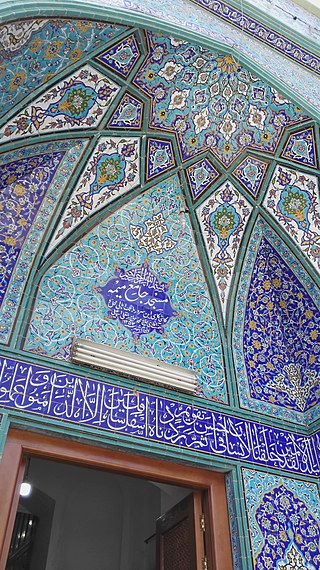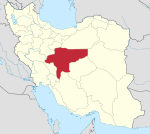
Naqsh-e Jahan Square, also known as the Shah Square prior to 1979, is a square situated at the center of Isfahan, Iran. Constructed between 1598 and 1629, it is now an important historical site, and one of UNESCO's World Heritage Sites. It is 160 metres (520 ft) wide by 560 metres (1,840 ft) long. It is also referred to as Shah Square or Imam Square. The square is surrounded by buildings from the Safavid era. The Shah Mosque is situated on the south side of this square. On the west side is the Ali Qapu Palace. Sheikh Lotf Allah Mosque is situated on the eastern side of this square and at the northern side Qeysarie Gate opens into the Isfahan Grand Bazaar. Today, Namaaz-e Jom'eh is held in the Shah Mosque.
Golpayegan, also Romanized as Golpāyegān; also known as Shahr-e Golpāyegān, meaning City of Golpayegan, is a city in the Central District of Golpayegan County, Isfahan province, Iran, serving as capital of both the county and the district. The city is 186 kilometres (116 mi) northwest of Isfahan and 102 kilometres (63 mi) southeast of Arak, at an altitude of 1,830 m. Its temperature fluctuates between +37 and -10 °C. Its average annual rainfall is 300 mm.

Falavarjan County is in Isfahan province, Iran. Its capital is the city of Falavarjan.

The Jāmeh Mosque of Isfahān or Jāme' Mosque of Isfahān, also known as the Atiq Mosque and the Friday Mosque of Isfahān, is a historic congregational mosque (Jāmeh) of Isfahan, Iran. The mosque is the result of continual construction, reconstruction, additions and renovations on the site from around 771 to the end of the 20th century. The Grand Bazaar of Isfahan can be found towards the southwest wing of the mosque. It has been a UNESCO World Heritage Site since 2012. It is one of the largest and most important monuments of Islamic architecture in Iran.
The Agha Nour mosque is a mosque located in Isfahan, Iran. It was founded during the Shah Abbas I era and completed during the Shah Safi era, and as such the names of both kings were mentioned in the inscription above the portal of the mosque. The mosque was built under the supervision of Noureddin Mohammad Esfahani, who was one of the richest men in Isfahan. The Shabestan of this mosque is one of the most beautiful Shabestans in Isfahan. This Shabestan has stone pillars with marble arches, which provide light during the day.
Ilchi mosque is a historical mosque in Isfahan, Iran. The founder of this small and simple mosque was Saheb Soltan Beigom, the daughter of a courtier in the Shah Suleiman's court. The word Ilchi (elçi) means messenger in Azeri. The mosque was built in 1686 under the supervision of Mohammad Ali ben Ostad ALibeyk.

Seyyed Mosque is a historic 19th-century mosque located in Isfahan, Iran. It was built during the rule of the Qajar dynasty, by the Shi'ite cleric Mohammad Bagher Shafti, one of the first clerics to receive the rank of Hujjatul Islam. The mosque itself is active, but its construction is not entirely complete.

Mohammad Jafar Abadei Mosque is a historical mosque in Isfahan, Iran. It was built in 1878 by the famous clergyman of the Qajar era, Mohammad Jafar Abadei. The mosque is famous because of its tiles and its architecture.

Rahim Khan Mosque is a historical mosque in Isfahan, Iran. It was built in the late 19th century. This mosque has an unusual combination of styles in architectural decorations. The shabestan of this mosque is one of the biggest shabestans in Isfahan. The shabestan, portal, iwan and outer surface of the mosque's dome have been rebuilt.
The Jameh Mosque of Khozan is a historical mosque in the Khomeyni Shahr County of the Isfahan Province. The original building of the mosque dated back to the Timurid era in the 15th century, but it's improbable that the current building to be older than the Safavid era. The mosque has four iwans. The southern iwan leads to the inner space of the dome. The inner space of the dome is decorated by muqarnas. The walls of the mosque are covered by stones and bricks. The arches of the northern and southern iwans are decorated with some paintings from the Safavid era., but the paintings of the eastern and western iwans seem to belong to the Qajar era. The shabestan of the mosque is behind the western iwan. There are 20 stone columns with the height of 2 m in the shabestan. The shabestan had been lit originally with the marble stones of the ceiling, but during the recent reparations, these marble stones have been removed.
The Dashti Mosque is a historical mosque in Dashti village in the Isfahan Province, Iran. It is one of the most famous structures of the Ilkhanid era. There is no inscription in or on the mosque, on which the construction year and the architect's name has been mentioned.
The Gar mosque and minaret are historical structures located in Gar village in the Isfahan province. The minaret dates back to Seljuq era, but the mosque belongs to the Ilkhanid age. The only remained part of the mosque is its mihrab, which has been decorated with stuccoes, but the minaret is relatively in a good condition and according to its inscription, it was built in 1121 by Abolghassem ebn-e Ahmad.

The Barsian mosque and minaret are historical structures in the Isfahan province. Barsian, which was originally Parsian in the past, is a village located 42 km east of Isfahan. According to the inscriptions the mosque was built in 1105 and the minaret was built in 1098 in the era of Barkiyaruq, the Seljuq king. The minaret is the fourth oldest minaret in Iran, which has an inscription. It is 34 m high. Its bottom part has simple bricks, but the upper parts have been decorated by decorative bricks.

The Kaj Mosque is a historical mosque located in the Isfahan province of Iran, situated 24 km east of Isfahan on the northern bank of Zayandeh Rud. Currently, only some half-ruined walls and a dome remains from the mosque's original structure. It dates back to the Ilkhanid era. Brick is the most important construction material used for this structure. Even the inner decorations are made of bricks. The mosque had probably a minaret in the past, but there is no trace of it now.

The Hafshuye Mosque is a historical mosque in the Isfahan province, Iran. It dates back to the seljukid era. The main part of the mosque, especially its dome, has been destroyed and its wall has been damaged. The structure has been built mainly with adobes, but its facade has been worked with bricks.

The Meydan Mosque is a historical mosque in Kashan, Iran. It is located in the southern side of the Sang-e Ghadimi square and beside the Bazaar of Kashan. It is one of the oldest structures in Kashan. The primary structure belonged possibly to the seljuq era, but it was destroyed by the Mongols during their invasions. Later it was rebuilt and repaired by Khaje Emad ed-Din. A quotation for this matter is an inscription in the old mihrab, in which it is mentioned that it is built in 623 Hijri by Hassan ebn-e Arabschah in Kashan. The mihrab was in its original place until the last century, but it is kept now in the Museum of Islamic art in Berlin.
The Tabriziha Mosque is a historical mosque in Kashan, Iran. The mosque is located in Malek bazarche and belongs to the Qajar era. It was built by Mohammad Hosseyn Tabrizi. Both sides of its big door have been decorated with haftrang tiles. Its vestibule has a stucco inscription. The ceiling of its shabestan has 18 arches, which have been decorated with bricks and tiles. The columns have been covered with tiles. The four sides of shabestan and around the columns there are inscriptions of the verses of Koran. The inscriptions have been written in white Naskh on a persian blue background. The triangle under the inscriptions have been decorated with designs and shapes. The mihrab of the mosque has been decorated with tiles and has a stucco inscription. On the inscription, some Koran verses have been written in white Thuluth script on the ultramarine background.
The Darvazeh No Mosque is a historical mosque from the Qajar era in Isfahan, Iran.

The Jameh Mosque of Meymeh is a historical mosque in Meymeh, Iran. The mosque was built during the Safavid era.

The Mesri Mosque is a historical mosque in Isfahan, Iran. The mosque was built in 1650 in the Safavid era. There is an inscription in its mihrab, written by the famous calligrapher Mohammad Reza Emami in Nastaliq script.



























